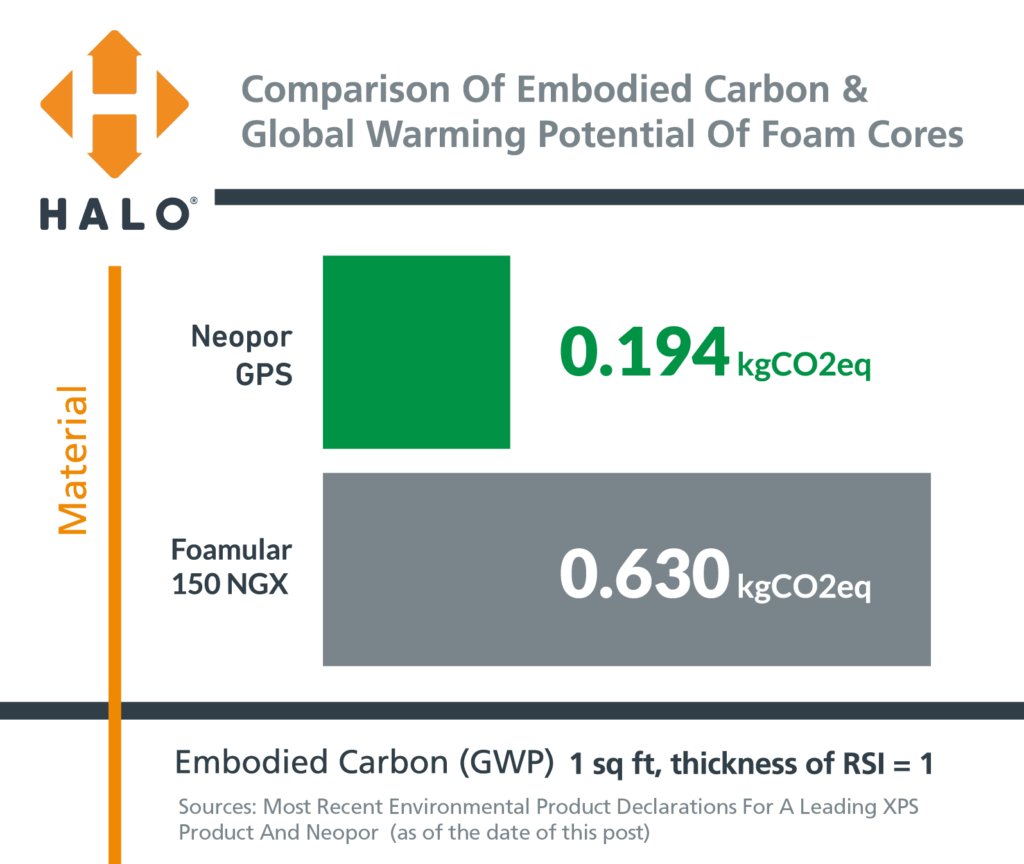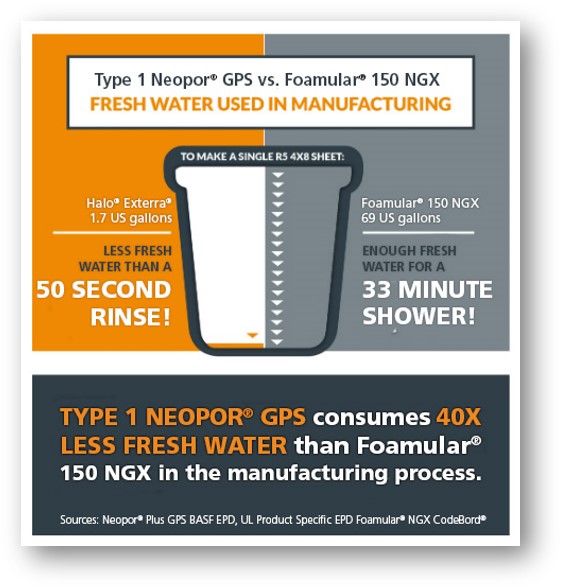On January 1st, 2021, several jurisdictions in the United States and Canada adopted new regulations that banned the use of blowing agents HFC-134A and HFC-142B.
These blowing agents emit greenhouse gases that are 1,420 and 2,310 times more damaging to the Earth’s climate than CO2 and both have been, and continue to be, used in the production of the ubiquitous Extruded Polystyrene (XPS) rigid insulation.
Due to these new restrictions, XPS manufacturers had to get creative with their product to continue selling it. (Mind you, at this time, the original high-carbon blowing agents are still used to produce many XPS products that are sold in the many states without the new ban).
But, in states where the old process is outlawed, XPS manufacturers have introduced new products to meet the new requirements. Enter Foamular 150 NGX. This rebranded product is one example of the new XPS foam boards that are intended to comply with the new laws.
We decided to compare its properties to Neopor, the graphite polystyrene (GPS Type 1) that is used to make Halo® Exterra® and Interra®.
We considered R-value, embodied carbon, and the number of resources (raw materials, energy, and water) consumed in production. This comparison was made referencing published environmental product declarations and published sell sheets for both foams.
Let’s have a look.

R-Values
The new Foamular 150 NGX has an initial R-value of R5/inch and this is the same as regular Foamular has.
However, it’s R-value will deteriorate over time, as is the case with regular Foamular as well. In fact, the NGX product warranty only promises an R-value of R4.5/in after 5 years.
In contrast, Halo’s GPS offers a thermal resistance of R5/nominal inch (1.06″) after 5 years.
And because GPS doesn’t deteriorate over time as XPS does, its R-value remains stable at R5/nominal inch (1.06″) over the long-term.
Vapor Permeance
Permeability equals breathability. Wood-framed cavity walls with a poly vapor barrier on the inside should have a breathable outside layer of continuous insulation in order to be able to dry to the outside.
This helps keep the wall cavity dry and mold-free.
NGX has the same low permeance characteristics as it’s Foamular predecessor. Thus, Halo’s Type 1 GPS is more than twice as permeable and much more breathable, enabling wood-frame walls to have a much better drying capacity.
Embodied Carbon
According to the Embodied Carbon in Construction Calculator (EC3), Foamular 150 NGX has 85% less Global Warming Potential (GWP) than its older, more carbon-laden peer. That said, the NGX still has a full 225% more GWP than the Type 1 GPS foam used in Halo products.


Don't miss a thing!
Subscribe for exclusive content, insider industry news and limited edition webcasts.
Mass of Foam Used in Production
The manufacturing process of Foamular 150 NGX requires the same foam mass as that of regular Foamular. But that’s still a lot of foam. In contrast, Halo’s Type 1 GPS uses 44% less foam material to produce the same volume of foam board insulation.

Water Used in Production
This is where the Foamular 150 NGX really falls short.
Buried in the small print of its EPD is a critical indicator that reveals a disturbing figure — the new and “improved” XPS board consumes many times more fresh water in its production than its older version.
In fact, it takes an incredible 69 gallons of fresh water to make a single R5 4×8 sheet of the NGX product!
Let’s stop for a moment and consider this disturbing amount of freshwater consumption. And let’s ask ourselves: why would one bother specifying low-flow toilets and showerheads while needlessly consuming thousands of gallons of freshwater specifying an insulation product like this?
In contrast, the GPS used in Halo requires 40X less freshwater than the NGX product in its manufacturing process by volume.
Wrapping it up
Across the criterion we’ve analyzed above, one thing is obvious.
The new Foamular 150 NGX uses more resources than Halo’s Type 1 GPS, yet creates a foam board product with higher global warming potential and a lower long-term thermal resistance.
Despite requiring much more foam and freshwater than GPS in its manufacturing process, this new XPS foam is still much less breathable and still can’t retain its R-value after 5 years of service while GPS R-values stay consistent and endure.
The verdict — based on this comparison it would appear that XPS manufacturers simply tweaked a few components so they can meet the new regulations and continue selling their product. What they didn’t appear to do is address the fundamental underlying issues with their manufacturing process.









